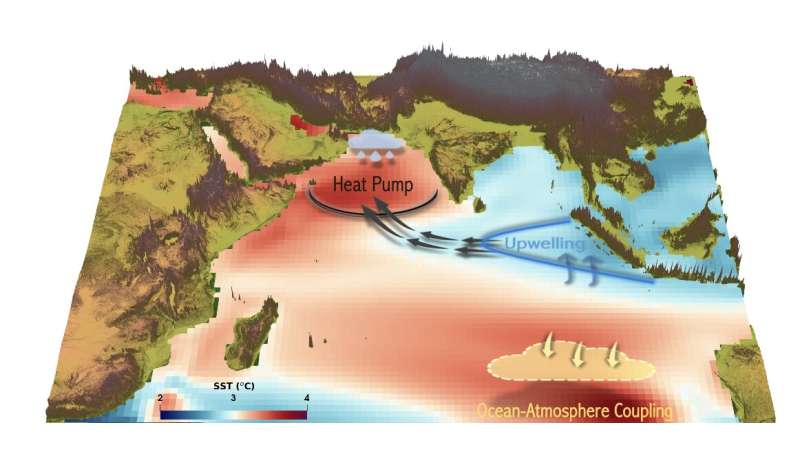This article has been reviewed according to Science X's editorial process and policies. Editors have highlighted the following attributes while ensuring the content's credibility:
fact-checked
peer-reviewed publication
trusted source
proofread
Climate scientists uncover mechanisms behind uneven Indian Ocean warming

A study published in Nature Communications by an international team of climate scientists uncovers the physical mechanisms that can cause uneven future warming in the Indian Ocean and corresponding shifts in monsoon precipitation.
Even as temperatures are rising globally, some areas warm faster than others in response to increasing greenhouse gas concentrations. The corresponding climate change temperature difference pattern causes large-scale changes in winds and weather systems, impacting societies and ecosystems.
Previous work has mainly focused on the well-known Arctic amplification pattern and on the projected east/west temperature difference in the equatorial Pacific, which in turn can impact regions far outside the tropics. Little attention has been paid so far on the mechanisms that cause uneven heating in the Indian Ocean and related impacts on wind and rainfall in the adjacent land area.
By analyzing data from one of the most extensive future climate change simulations performed to date (the ICCP/CESM Large-Ensemble simulation of the Community Earth System Model, version 2), the team of scientists from South Korea and Japan were able to pinpoint why over the next decades the tropical eastern Indian Ocean is expected to warm less than the Arabian Sea and the Southeastern Indian Ocean.
A key area identified by the researchers to explain the uneven Indian Ocean warming is the area west of Indonesia, where under present-day conditions colder deep waters occasionally upwells to the surface. This connection between surface and deeper ocean waters serves as a thermostat, which explains the weakened future regional warming signal relative to other Indian Ocean areas. In the tropics, air rises in warmer areas and tends to sink in colder regions. The reduced eastern equatorial Indian warming is therefore accompanied by higher than normal sea level pressure and winds which blow towards the Arabian Sea.
"Changes in the winds automatically influence the ocean circulation. In our case, stronger future winds blowing from Indonesia towards the Arabian Peninsula push more tropical waters towards the Arabian Sea. This leads to an accelerated warming of the ocean there," says Sahil Sharma, Ph.D. student at the IBS Center for Climate Physics (ICCP) and Pusan National University, South Korea and first author of the study.
"Enhanced future warming in the Arabian Sea will further reduce atmospheric surface pressure and generate more rainfall, also in the adjacent regions. In fact, climate models show on average a 50% intensification of mean rainfall over the southern Arabian Peninsula and parts of western India by year 2100, if CO2 emissions are not cut drastically," says Prof. Kyung-Ja Ha from the IBS Center for Climate Physics and Pusan National University and corresponding author of the study.
The authors further highlighted the southeastern Indian ocean as a regional global warming hotspot. In this region, future surface warming induced by greenhouse gases can be further amplified by a reduction of clouds and more sunshine arriving at the surface of the ocean.
"The Indian Ocean is a peculiar region. Ocean currents are less efficient in transporting excess heating from Global Warming to higher latitudes, as compared to other ocean basins. The northern transport route is blocked by land. This means that we find a very different temperature response pattern in the Indian Ocean, which emerges from a combination of oceanic and atmospheric processes, including winds and clouds," says Dr. Keith Rodgers from the IBS Center for Climate Physics, co-author of the study.
This study was made possible by using a climate computer model experiment, which was previously conducted on the ICCP/IBS supercomputer Aleph. Rather than running a climate model only once into the future for a given greenhouse gas forcing, the researcher ran 100 simulations into the future, which represent different realizations of the internal variability in the climate system.
This new modeling resource has been instrumental in identifying the complex interplay between ocean and atmosphere which is responsible for the Indian Ocean warming pattern. This understanding will be useful for informing fisheries and other marine resource management concerns.
The research team will further explore how climate change will impact other regional processes in the Indian Ocean area, including marine ecosystems and sea level.
More information: Sahil Sharma et al, Future Indian Ocean warming patterns, Nature Communications (2023). DOI: 10.1038/s41467-023-37435-7
Journal information: Nature Communications
Provided by Institute for Basic Science





















